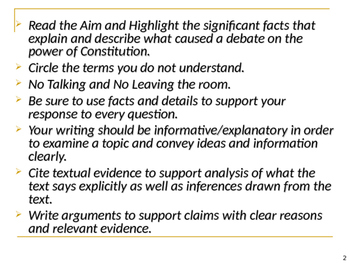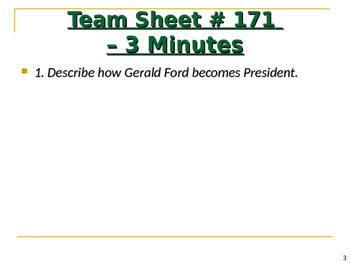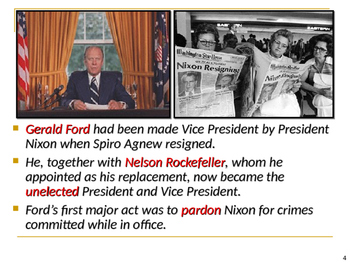U.S. Aim # 171 What is meant by “Ford to city: drop dead?”
The Personette Class Page
107 Followers
Grade Levels
9th - 12th
Subjects
Resource Type
Formats Included
- PPT
The Personette Class Page
107 Followers
Description
U.S. Aim # 171 What is meant by “Ford to city: drop dead?”
Objectives – Students will be able to
Cite information from an informational text to support a conclusion or argument.
Define words they do not know using context clues.
Identify and describe what caused a debate on the power of Constitution.
Do Now – 3 Minutes
1. Compare and contrast Woodward and Bernstein’s Deep Throat, to Julian Assange’s Wikileaks, and are they good or bad for a society.
Mini - Lesson: (Teaching Point) - 10 Minutes
Review reading passage
Power Point Aim, with, hyperlinked video and
Student teacher randomized calling
Questions based on Primary and Secondary source documents
Homework # 171 - Define
1. Gerald Ford
2. Jimmy Carter
3. OPEC
4. Three Mile Island
Task: Independent Work - 12 Minutes
Students will read regents level material-
Read the Aim and Highlight the significant facts that explain and describe what caused a debate on the power of Constitution.
Circle the terms you do not understand.
No Talking and No Leaving the room.
Be sure to use facts and details to support your response to every question.
Your writing should be informative/explanatory in order to examine a topic and convey ideas and information clearly.
Cite textual evidence to support analysis of what the text says explicitly as well as inferences drawn from the text.
Write arguments to support claims with clear reasons and relevant evidence.
Vocabulary Review – 3 Minutes
Students will circle the terms they do not understand.
Class will use context clues, prior knowledge, textbooks, and dictionaries to find out the meaning of the terms unknown.
In groups, students will answer questions related to the reading - 3 Minutes Each – 12 Minutes Total
Team Sheet # 171 – 3 Minutes Each
1. Describe how Gerald Ford becomes President.
2. Describe why President Ford pardoned President Nixon.
3. Describe what OPEC is and why they dislike America.
4. Describe why Inflation was happening in the 1970s.
Student Share - 15 Minutes
Students will pull information from reading handout to explain their team sheet questions. Each answer must be supported by the reading.
Students will be able to answer material relevant questions.
Exit Ticket –
Students will answer close out questions displaying depth of knowledge
Question # 171
What actions triggered the recessions of 1974 and 1979?
1. High unemployment that reduced the number of jobs.
2. Reduction in tax levels.
3. Rising oil prices that created inflation.
4. The raising of interest rates by the Federal Reserve.
Assessment –
Students will be able to answer pertinent questions related to the material, graded work including do now and team sheet.
Standards -
1. Use the historical method of inquiry to ask questions, evaluate primary and secondary sources, critically analyze and interpret data, and develop interpretations defended by evidence a. Evaluate a historical source for point of view and historical context (DOK 2 ‐ 3) b. Gather and analyze historical information, including contradictory data, from a variety of primary and secondary sources, including sources located on the Internet, to support or reject hypotheses (DOK 1 ‐ 3) c. Construct and defend a written historical argument using relevant primary and secondary sources as evidence (DOK 1 ‐ 3) d. Differentiate between facts and historical interpretations, recognizing that a historian's narrative reflects his or her judgment about the significance of particular facts (DOK 2 ‐ 3)
2. The key concepts of continuity and change, cause and effect, complexity, unity and diversity over time World history (both East and West including modern world history): a. Evaluate continuity and change over the course of world history (DOK 1 ‐ 3) b. Investigate causes and effects of significant events in world history (DOK 1 ‐ 2) c. Analyze the complexity of events in world history (DOK 2 ‐ 3) d. Examine and evaluate issues of unity and diversity in world history (DOK 1 ‐ 3) United States history (Reconstruction to the present): e. Analyze continuity and change in eras over the course of United States history (DOK 2 ‐ 3) f. Investigate causes and effects of significant events in United States history. Topics to include but not limited to WWI, Great Depression, Cold War (DOK 1 ‐ 2) g. Analyze the complexity of events in United States history. Topics to include but not limited to the suffrage movement and the Civil Rights Movement (DOK 2 ‐ 3) h. Examine and evaluate issues of unity and diversity from Reconstruction to present. Topics to include but not limited to the rise and fall of Jim Crow, role of patriotism, and the role of religion (DOK 1 ‐ 3)
The significance of ideas as powerful forces throughout history World history (both East and West including modern world history) a. Discuss the historical development and impact of major world religions and philosophies. Topics to include but not limited to the Enlightenment and modern changes in Christianity, Islam, Judaism, Buddhism and Hinduism (DOK 1 ‐ 3) b. Investigate the historical development of and impact of major scientific and technological innovations. Topics to include but not limited to the Industrial Revolution (DOK 1 ‐ 3) c. Evaluate the historical development and impact of political thought, theory and actions (DOK 1 ‐ 3) d. Analyze the origins of fundamental political debates and how conflict, compromise, and cooperation have shaped national unity and diversity. Topics to include but not limited to suffrage, Civil Rights and the role of government (DOK 1 ‐ 3) e. Analyze ideas critical to the understanding of American history. Topics to include but not limited to populism, progressivism, isolationism, imperialism, anti ‐ communism, environmentalism, liberalism, fundamentalism, and conservatism (DOK 1 ‐ 3) f. Describe and analyze the historical development and impact of the arts and literature on the culture of the United States (DOK 1 ‐ 3)
Objectives – Students will be able to
Cite information from an informational text to support a conclusion or argument.
Define words they do not know using context clues.
Identify and describe what caused a debate on the power of Constitution.
Do Now – 3 Minutes
1. Compare and contrast Woodward and Bernstein’s Deep Throat, to Julian Assange’s Wikileaks, and are they good or bad for a society.
Mini - Lesson: (Teaching Point) - 10 Minutes
Review reading passage
Power Point Aim, with, hyperlinked video and
Student teacher randomized calling
Questions based on Primary and Secondary source documents
Homework # 171 - Define
1. Gerald Ford
2. Jimmy Carter
3. OPEC
4. Three Mile Island
Task: Independent Work - 12 Minutes
Students will read regents level material-
Read the Aim and Highlight the significant facts that explain and describe what caused a debate on the power of Constitution.
Circle the terms you do not understand.
No Talking and No Leaving the room.
Be sure to use facts and details to support your response to every question.
Your writing should be informative/explanatory in order to examine a topic and convey ideas and information clearly.
Cite textual evidence to support analysis of what the text says explicitly as well as inferences drawn from the text.
Write arguments to support claims with clear reasons and relevant evidence.
Vocabulary Review – 3 Minutes
Students will circle the terms they do not understand.
Class will use context clues, prior knowledge, textbooks, and dictionaries to find out the meaning of the terms unknown.
In groups, students will answer questions related to the reading - 3 Minutes Each – 12 Minutes Total
Team Sheet # 171 – 3 Minutes Each
1. Describe how Gerald Ford becomes President.
2. Describe why President Ford pardoned President Nixon.
3. Describe what OPEC is and why they dislike America.
4. Describe why Inflation was happening in the 1970s.
Student Share - 15 Minutes
Students will pull information from reading handout to explain their team sheet questions. Each answer must be supported by the reading.
Students will be able to answer material relevant questions.
Exit Ticket –
Students will answer close out questions displaying depth of knowledge
Question # 171
What actions triggered the recessions of 1974 and 1979?
1. High unemployment that reduced the number of jobs.
2. Reduction in tax levels.
3. Rising oil prices that created inflation.
4. The raising of interest rates by the Federal Reserve.
Assessment –
Students will be able to answer pertinent questions related to the material, graded work including do now and team sheet.
Standards -
1. Use the historical method of inquiry to ask questions, evaluate primary and secondary sources, critically analyze and interpret data, and develop interpretations defended by evidence a. Evaluate a historical source for point of view and historical context (DOK 2 ‐ 3) b. Gather and analyze historical information, including contradictory data, from a variety of primary and secondary sources, including sources located on the Internet, to support or reject hypotheses (DOK 1 ‐ 3) c. Construct and defend a written historical argument using relevant primary and secondary sources as evidence (DOK 1 ‐ 3) d. Differentiate between facts and historical interpretations, recognizing that a historian's narrative reflects his or her judgment about the significance of particular facts (DOK 2 ‐ 3)
2. The key concepts of continuity and change, cause and effect, complexity, unity and diversity over time World history (both East and West including modern world history): a. Evaluate continuity and change over the course of world history (DOK 1 ‐ 3) b. Investigate causes and effects of significant events in world history (DOK 1 ‐ 2) c. Analyze the complexity of events in world history (DOK 2 ‐ 3) d. Examine and evaluate issues of unity and diversity in world history (DOK 1 ‐ 3) United States history (Reconstruction to the present): e. Analyze continuity and change in eras over the course of United States history (DOK 2 ‐ 3) f. Investigate causes and effects of significant events in United States history. Topics to include but not limited to WWI, Great Depression, Cold War (DOK 1 ‐ 2) g. Analyze the complexity of events in United States history. Topics to include but not limited to the suffrage movement and the Civil Rights Movement (DOK 2 ‐ 3) h. Examine and evaluate issues of unity and diversity from Reconstruction to present. Topics to include but not limited to the rise and fall of Jim Crow, role of patriotism, and the role of religion (DOK 1 ‐ 3)
The significance of ideas as powerful forces throughout history World history (both East and West including modern world history) a. Discuss the historical development and impact of major world religions and philosophies. Topics to include but not limited to the Enlightenment and modern changes in Christianity, Islam, Judaism, Buddhism and Hinduism (DOK 1 ‐ 3) b. Investigate the historical development of and impact of major scientific and technological innovations. Topics to include but not limited to the Industrial Revolution (DOK 1 ‐ 3) c. Evaluate the historical development and impact of political thought, theory and actions (DOK 1 ‐ 3) d. Analyze the origins of fundamental political debates and how conflict, compromise, and cooperation have shaped national unity and diversity. Topics to include but not limited to suffrage, Civil Rights and the role of government (DOK 1 ‐ 3) e. Analyze ideas critical to the understanding of American history. Topics to include but not limited to populism, progressivism, isolationism, imperialism, anti ‐ communism, environmentalism, liberalism, fundamentalism, and conservatism (DOK 1 ‐ 3) f. Describe and analyze the historical development and impact of the arts and literature on the culture of the United States (DOK 1 ‐ 3)
Total Pages
Answer Key
N/A
Teaching Duration
50 minutes
Report this resource to TPT
Reported resources will be reviewed by our team. Report this resource to let us know if this resource violates TPT’s content guidelines.





